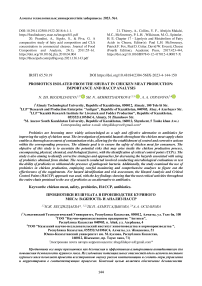Probiotics isolated from the shubat in chicken meat production: importance and HACCP analysis
Автор: Begdildayeva N.Zh., Akhmetsadykova Sh.N., Ospanova A.A.
Журнал: Вестник Алматинского технологического университета @vestnik-atu
Рубрика: Технология пищевой и перерабатывающей промышленности
Статья в выпуске: 4 (142), 2023 года.
Бесплатный доступ
Probiotics are becoming more widely acknowledged as a safe and effective alternative to antibiotics for improving the safety of chicken meat. The investigation of potential hazards throughout the chicken meat supply chain enables a thorough assessment of contamination risks, allowing for the establishment of control and corrective actions within the corresponding processes. The ultimate goal is to ensure the safety of chicken meat for consumers. The objective of this study is to ascertain the potential risks that may arise inside the chicken production process, encompassing physical, chemical, and biological factors, with the identification of critical control points (CCPs). The study is also aiming to identify corrective strategies and approaches for decreasing the hazards associated with using of probiotics obtained from shubat. The research conducted involved conducting microbiological evaluations to test the ability of probiotics to withstand the presence of pathogenic bacteria. Additionally, the study examined the use of probiotics in chicken production, employing careful monitoring and comprehensive analyses to figure out the effectiveness of the supplements. For hazard identification and risk assessment, the Hazard Analysis and Critical Control Points (HACCP) approach was used, with the key findings showing that the most critical activities throughout the entire chain pertained to the use of probiotics as an alternative to antibiotics.
Chicken meat, safety, probiotics, haccp, antibiotics
Короткий адрес: https://sciup.org/140303459
IDR: 140303459 | DOI: 10.48184/2304-568X-2023-4-144-150
Список литературы Probiotics isolated from the shubat in chicken meat production: importance and HACCP analysis
- Chmiel, M., Roszko, M., Hać-Szymańczuk, E., Cegiełka, A., Adamczak, L., Florowski, T., and Świder, O. Changes in the microbiological quality and content of biogenic amines in chicken fillets packed using various techniques and stored under different conditions. Food Microbiology, 2022, 102, 103920. https://doi.org/10.1016/j.fm.2021.103920
- Alayande, K. A., Aiyegoro O. A., Ateba C. N. Probiotics in animal husbandry: Applicability and associated risk factors. Sustainability, 2020, 12 (3), 1087. https://doi.org/10.3390/su12031087
- Rolhion, N., Chassaing B. When pathogenic bacteria meet the intestinal microbiota. Philosophical Transactions of the Royal Society B: Biological Sciences. 2016, 371(1707), 15-20. https://doi.org/10.1098/rstb.2015.0504
- Bhogoju, S., Nahashon S. Recent advances in probiotic application in animal health and nutrition: A review. Agriculture, 2022, 12 (2), 304. https://doi.org/10.3390/agriculture12020304
- Chen, H., Liu, S., Chen, Y., Chen, C., Yang, H., & Chen, Y. Food safety management systems based on ISO 22000: 2018 methodology of hazard analysis compared to ISO 22000: 2005. Accreditation and Quality Assurance, 2020, 25, 23-37. https://doi.org/10.1007/s00769-019-01409-4
- 6.Maunsell B., Bolton D. J. Guidelines for food safety management on farms. Food Safety Department, Teagasc -The National Food Centre, 2004.
- Arendt, M., Elissa, J., Schmidt, N., Michael, E., Potter, N., Cook, M., & Knoll, L. J. Investigating the role of interleukin 10 on Eimeria intestinal pathogenesis in broiler chickens. Veterinary immunology and immunopathology, 2019, 218, 32-34. https://doi.org/10.1016.2019.109934
- Shields, S. J., Garner J. P., Mench J. A. Effect of sand and wood-shavings bedding on the behavior of broiler chickens. Poultry science. 2005, 84 (12), 1816-1824. https://doi.org/10.1093/ps/84.12.1816
- Abadi, M. H. M. G., Moravej, H., Shivazad, M., Torshizi, M. A. K., & Kim, W. K. (2019). Effect of different types and levels of fat addition and pellet binders on physical pellet quality of broiler feeds. Poultry science, 98(10), 4745-4754. https://doi.org/10.3382/ps/pez190
- Yeleusizova, A., Aisin, M., & Dyusembekov, S. (2023). Evaluation of the sanitary and hygienic characteristics of chicken meat and semi-finished products. Ġylym ža̋ ne bìlìm, 1 (70), 27-34. https://doi.org/10.52578/2305-9397-2023-1-1-27-34
- Guergueb, N., Alloui, N., Ayachi, A., & Bennoune, O. (2014). Effect of slaughterhouse hygienic practices on the bacterial contamination of chicken meat. Scientific Journal of Veterinary Advances, 3(5), 71-76. doi:10.14196/sjvs.v3i5.1405
- Faridi, A., Gitoee, A., Donato, D. C. Z., France, J., & Sakomura, N. K. (2016). Broiler responses to digestible threonine at different ages: a neural networks approach. Journal of Animal Physiology and Animal Nutrition, 100(4), 738-747. https://doi.org/10.1111/jpn.12373
- Ismail, I., & Joo, S. T. (2017). Poultry meat quality in relation to muscle growth and muscle fiber characteristics. Korean journal for food science of animal resources. 37(6), 873. https://doi.org/10.5851%2Fkosfa.2017.37.6.87
- Nam, I. S. (2017). The implementation and effects of HACCP system on broiler farms in Korea. JAPS: Journal of Animal & Plant Sciences. 27(6). https://doi.org/10.1016/j.jclepro.2020.124231
- Leonov, O. A., Shkaruba, N. Z., Cherkasova, E. I., & Odintsova, A. A. (2020, April). Quality assessment of temperature measurements in incoming inspection of raw meat. In Journal of Physics: Conference Series. Vol. 1515, No. 3, p. 032030. DOI 10.1088/1742-6596/1515/3/032030


